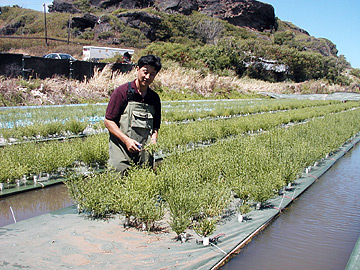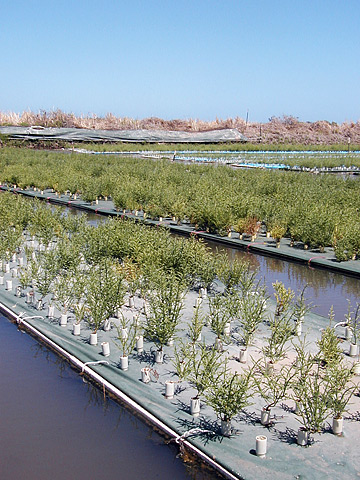Sea greens
Sea asparagus grown hydroponically in Kahuku makes it to island markets
PERHAPS if you were a mouse, a stalk of this sea green would look like asparagus. But to a full-sized human being -- nah.
It's called sea asparagus, a name that's not fooling anybody. It looks more like seaweed, but it's not that. While growing it looks like a tiny Christmas tree, but it's not that, either.
So -- what?
Officially, sea asparagus belongs to the genus Salicornia, making it a distant relative of beets and spinach, but it's certainly neither of those.
It is an intertidal plant, which means it grows in brackish water near the edge of the ocean, but not in Hawaii.

BETTY SHIMABUKURO / BSHIMABUKURO@STARBULLETIN.COM
Wenhao Sun, president of Marine Agri-Future, uses scissors to trim sea asparagus growing on platforms floating in a Kahuku shrimp pond.
|
|
All things considered, though, it should grow here, given our proclivity toward seaweedy foods. And now some adventurous researchers have seen that it does.
Sea asparagus is Oahu's latest hydroponic crop, growing on floating platforms on a Kahuku shrimp farm, and just beginning to show up on restaurant menus and in markets.
Marine Agri-Future is harvesting about 200 pounds of the stuff per week, with a year-end goal of selling 1,000 per month grown on as many as 46 platforms.
The current crop represents three years of work, President Wenhao Sun says. "First of all we figure out this can grow in sea water -- no problem. But we cannot get it to grow on our platform."
By May 2005, they had all the conditions right and began to grow in earnest. A pond borrowed from Ming Dynasty Shrimp and Fish Farm is now devoted to the sea asparagus platforms, fed by recycled water from shrimp-growing.
It's a lot of effort for something that grows wild in other parts of the world.
Jason Kagihara, chef de cuisine at Mariposa at Neiman Marcus, remembers foraging for the plant when he was working in Seattle, where it goes by the name sea beans. "It just grows right in the sand, real close to the water."
During the season -- basically the summer months -- he'd pick a 5-gallon bucket on each harvesting trip, to be pickled or sautéed at his restaurant, Lark.
"It tasted like the ocean. It kind of reminded me of ogo -- really briny, really fresh, crisp. ... When you put it in your mouth it bursts with all the flavor of the ocean."
Sea asparagus -- also called pickleweed, glasswort and by many other not-so-pretty names -- grows in the Pacific Northwest, Canada and all the way up to Alaska. It's also found wild in coastal parts of England and Europe, and is farmed in Mexico, in arid areas irrigated with piped-in seawater.

BETTY SHIMABUKURO / BSHIMABUKURO@STARBULLETIN.COM
Sea asparagus plants are started from seeds. In three weeks, when they're about 2 inches high, they're transferred to these PVC tubes filled with gravel. In another three or four weeks they'll be ready to transfer to the growing platforms.
|
|
Some sources credit it with positive digestive properties -- anti-flatulence being one. But mostly the briny little green has had a place in cuisines worldwide, going back centuries.
All of which gives it potential as an export product, Sun says. "French people, English people, naturally love sea asparagus, but they only have it in the summertime. There could be a big market there."
He's already securing buyers in Vancouver, Canada, and in Japan.
So it seems about time sea asparagus was discovered here.
Nalo Farms has taken on local sales of the product, introducing it to Marukai Wholesale Mart ($2.99 for 4 ounces) and to several Oahu chefs. It's now served at Alan Wong's, Indigo Eurasion Cuisine, the Mandarin, Sarento's Top of the I, Mariposa and Town.
At Mariposa, Kagihara says it's served pickled with hamachi and sautéed in a ragout mixed with corn and tomatoes and served with salmon.
Jason Peel, corporate sous chef for Roy's Restaurants, brought a supply back from the Kahuku pond for experimenting. He plans to include it in two dishes at Roy's Hawaii Kai this week: a seaweed salad accompanying miso-and-garlic-glazed ahi, and in a stir-fry with shrimp.
"I thought it was pretty cool," Peel says. "Something new, something local."
SUN, a former researcher with the University of Hawaii's College of Tropical Agriculture and Human Resources, worked with retired UH researcher Chung-Shih Tang to develop the process of cultivating "terrestrial plants" on platforms in seawater.
The university has a patent pending on the process, and Sun's private company holds the license for using it. He said it could be applied to growing other salt-tolerant edible species -- the next step in the company's research.
Currently, 25 platforms are covered in sea asparagus in various stages, on a pond of just under an acre. There's room for expansion.
The plants take about three months to mature, and each one can be harvested three times, about four weeks apart. Weeds aren't a problem, Sun says, and except for occasional worms, they draw no pests. When the mineral content of the water drops, some fertilizer may be sprayed over the plants. Otherwise, he said, it's not a needy crop.
"Sunshine and water," he says, "that's all."

BETTY SHIMABUKURO / BSHIMABUKURO@STARBULLETIN.COM
Each sea asparagus plant extends through a tube so that its roots reach the saltwater. Nutrients in water pumped from neighboring shrimp ponds nourish the plants.
|
|
Blanching improves flavor, cuts salt
Sea asparagus is very salty when raw, and slightly bitter. It should be blanched in boiling water for about 1 minute before eating to leach out some of the salt and astringency.
Immediately plunge blanched greens into ice water, to stop the cooking and prevent discoloring.
Find sea asparagus at Marukai Wholesale Mart. It comes packaged in 4-ounce containers for $2.99.
Look for a bright green color, watching out for dark spots or sliminess. You might want to open the container and check the sprigs in the center for discoloration, which is a sign of age.
Dean Okimoto of Nalo Farms, which is wholesaling the sea asparagus to restaurants and markets, makes a simple lomi-tomato dish combining the sea asparagus with vine-ripened tomatoes andonion chives.
It's also a natural for Japanese-style pickles such as namasu. Here are recipes for that and other dishes.
Sea Asparagus Namasu
2 medium Japanese cucumbers
1 teaspoon salt
4 ounces sea asparagus
» Dressing:
1/3 cup Japanese rice vinegar
1/4 cup sugar
1 teaspoon salt
Trim ends of cucumbers; cut in half lengthwise and scrape out seeds. Slice thinly. Place slices in colander and toss with 1 teaspoon salt. Let sit 10 minutes (this draws excess water out of cucumbers).
Blanch sea asparagus in boiling water 1 to 2 minutes. Remove immediately to an ice-water bath. Drain.
Rinse cucumbers and squeeze out water. Toss with sea asparagus.
Combine dressing ingredients, stirring to dissolve sugar. Pour over vegetables and toss. Serves 6.
Approximate nutritional analysis, per serving: 45 calories, no fat or cholesterol, about 800 mg sodium, 11 g carbohydrate, 1 g fiber, 10 g sugar, 1 g protein.
Variation: Cherry tomatoes (cut in half) and thinly sliced Maui onion may be added in place of some of the cucumbers.
Sautéed Sea Asparagus
Marine Agri-Future
1/2 pound sea asparagus
1 shallot, minced
2 ounces butter
Lemon juice, to taste
Blanch sea asparagus in boiling water 1 to 2 minutes. Rinse immediately in cold water; drain.
Sauté shallot in butter over very low heat, 5 minutes. Do not let burn. Add asparagus and sauté 2 to 3 minutes. Sprinkle with lemon juice.
Approximate nutritional analysis, per serving: 120 calories, 12 g total fat, 7 g saturated fat, 30 mg cholesterol, 800 mg sodium, 3 g carbohydrate, 1 g fiber, 1 g sugar, 1 g protein.
Pickled Sea Asparagus
Marine Agritech
3 pounds sea asparagus
1 tablespoon pickling spice
3 to 5 garlic cloves
3-1/2 cups white wine vinegar
3-1/2 cups water
1-3/4 cups sugar
Clean asparagus and soak in cold water 1 hour. Drain. Chop into 2 to 3-inch lengths.
Place spices and garlic into sterilized jars. Pack sea asparagus tightly into jars.
Bring vinegar, water and sugar to boil and simmer 15 minutes. Pour hot solution into jars, leaving 1/2 inch headroom. Seal jars and process in hot-water bath 15 minutes. Makes about 10 pints.
Nutritional information unavailable.
Note: Will be pickled in 2 days, but taste improves with age. Eat as is, add to salads, or simply toss with sliced tomatoes.

